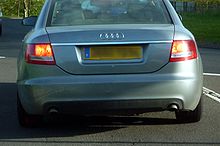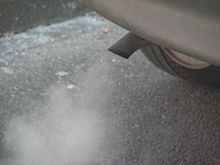- Motor vehicle emissions
-
 Typical appearance of car exhaust on a correctly maintained and warmed car. 99.4% of pollutant gases are invisible[1]
Typical appearance of car exhaust on a correctly maintained and warmed car. 99.4% of pollutant gases are invisible[1]
Motor vehicle emissions are composed of the by-products that comes out of the exhaust systems or other emissions such as gasoline evaporation. These emissions contribute to air pollution and are a major ingredient in the creation of smog in some large cities.[2][3][4][5]
Contents
NOx
 Smog in New York City as viewed from the World Trade Center in 1988. A 2009 report indicates that, despite the City's air being close to the EPA's short-term ozone standard, that New Yorkers still face a 25 per-cent increased risk of dying from lung disease.[6]
Smog in New York City as viewed from the World Trade Center in 1988. A 2009 report indicates that, despite the City's air being close to the EPA's short-term ozone standard, that New Yorkers still face a 25 per-cent increased risk of dying from lung disease.[6]
Mono-nitrogen oxides NO and NO2 react with ammonia, moisture, and other compounds to form nitric acid vapor and related particles. Small particles can penetrate deeply into sensitive lung tissue and damage it, causing premature death in extreme cases. Inhalation of such particles may cause or worsen respiratory diseases such as emphysema, bronchitis it may also aggravate existing heart disease.[7][8][9] In a 2005 U.S. EPA study the largest emissions of NOx came from on road motor vehicles, with the second largest contributor being non road equipment which is mostly gasoline and diesel stations.[9]
Volatile Organic Compounds
 Source: http://www.epa.gov/air/emissions/voc.htm . Non road equipment is mostly gasoline and diesel stations.
Source: http://www.epa.gov/air/emissions/voc.htm . Non road equipment is mostly gasoline and diesel stations.
When oxides of nitrogen (NOx) and volatile organic compounds (VOCs) react in the presence of sunlight, ground level ozone is formed, a primary ingredient in smog. A 2005 U.S. EPA report gives road vehicles as the second largest source of VOCs in the U.S. at 26% and 19% are from non road equipment which is mostly gasoline and diesel stations.[10] 27% of VOC emissions are from solvents which are used in the manufacturer of paints and paint thinners and other uses.[11]
Ozone
Ozone is beneficial in the upper atmosphere, but at ground level ozone irritates the respiratory system, causing coughing, choking, and reduced lung capacity.[12] In the United States, ozone is responsible for an estimated $500 million in reduced crop production each year.[13]
Carbon monoxide (CO)
Carbon monoxide poisoning is the most common type of fatal air poisoning in many countries.[14] Carbon monoxide is colorless, odorless and tasteless, but highly toxic. It combines with hemoglobin to produce carboxyhemoglobin, which is ineffective for delivering oxygen to bodily tissues. In the U.S. 60% of carbon monoxide is caused by on road vehicles.[15]
Hazardous air pollutants (toxics)
Chronic (long-term) exposure to benzene (C6H6) damages bone marrow. It can also cause excessive bleeding and depress the immune system, increasing the chance of infection. Benzene causes leukemia and is associated with other blood cancers and pre-cancers of the blood.[16][17]
Particulate Matter (PM10 and PM2.5)
The health effects of inhaling particulate matter have been widely studied in humans and animals and include asthma, lung cancer, cardiovascular issues, and premature death. Because of the size of the particles, they can penetrate the deepest part of the lungs.[18] A 2011 UK study estimates 90 deaths per year due to passenger vehicle PM.[19] In a 2006 publication, the U.S. Federal Highway Administration (FHWA) state that in 2002 about 1 per-cent of all PM10 and 2 per-cent of all PM2.5 emissions came from the exhaust of on-road motor vehicles (mostly from diesel engines).[20]
Carbon dioxide (CO2)
Carbon dioxide is a greenhouse gas. Motor vehicle CO2 emissions are part of the anthropogenic contribution to the growth of CO2 concentrations in the atmosphere which is believed by a majority of scientists to play a significant part in climate change. Motor vehicles are calculated to generate about 20 per-cent of the European Union's man-made CO2 emissions, with passenger cars contributing about 12 per-cent.[21] The European Union average new car CO2 emissions figure dropped by 5.4 per-cent in the year to the first quarter of 2010, down to 145.6 g/km.[22]
Passenger car emissions summary
U.S. Environmental Protection Agency estimates of average passenger car emissions in the United States for July 2000[23] Component Emission Rate Annual pollution emitted Hydrocarbons 2.80 grams/mile 77.1 pounds (35.0 kg) Carbon Monoxide 20.9 grams/mile 575 pounds (261 kg) NOx 1.39 grams/mile 38.2 pounds (17.3 kg) Carbon Dioxide - Green house gas 0.916 pounds per mile (258 g/km) 11,450 pounds (5,190 kg) Localised effects
The California Air Resources Board (C.A.R.B.) found in studies that 50% or more of the air pollution (smog) in Southern California is due to car emissions.[citation needed][24]
See also
- Air_pollution#Most_polluted_cities
- Automobile#Environmental_impact
- Emission standard
- European emission standards
- Australian Design Rules
- Exhaust gas
- United States emission standards
- Vehicle emissions control
- Mobile source air pollution
References
- ^ http://www.transport.qld.gov.au/Home/General_information/Environment/Aircare/Aircare_motor_vehicle_pollution
- ^ http://yosemite.epa.gov/opa/admpress.nsf/6427a6b7538955c585257359003f0230/228d9bf38da42f7c8525743b006db951!OpenDocument&Start=1&Count=5&Expand=1
- ^ http://www.sierraclub.org/sprawl/report01/carsandtrucks.asp
- ^ http://library.thinkquest.org/26026/Environmental_Problems/smog_-_causes.html
- ^ http://www.epa.gov/air/ozonepollution/pdfs/smog.pdf
- ^ Bravender, Robin (2009-03-12). "Study links smog exposure to premature death". The New York Times. http://www.nytimes.com/gwire/2009/03/12/12greenwire-study-links-smog-exposure-to-premature-death-10098.html.
- ^ http://www.epa.gov/air/nitrogenoxides/health.html
- ^ http://www.epa.gov/air/noxfacts.pdf
- ^ a b http://www.epa.gov/air/emissions/nox.htm
- ^ http://www.epa.gov/air/emissions/voc.htm
- ^ http://toxics.usgs.gov/definitions/vocs.html
- ^ http://www.mercurynews.com/news/ci_14859219?nclick_check=1
- ^ http://www.epa.gov/air/ozonepollution/basic.html
- ^ Omaye ST. (2002). "Metabolic modulation of carbon monoxide toxicity". Toxicology 180 (2): 139–150. doi:10.1016/S0300-483X(02)00387-6. PMID 12324190.
- ^ http://www.epa.gov/air/emissions/co.htm
- ^ http://www.theaa.com/motoring_advice/car-buyers-guide/cbg_toxics.html
- ^ http://www.epa.gov/otaq/f02004.pdf
- ^ Region 4: Laboratory and Field Operations — PM 2.5 (2008).PM 2.5 Objectives and History. U.S. Environmental Protection Agency.
- ^ Mazzi, Eric A.; Dowlatabadi, Hadi (2007). "Air Quality Impacts of Climate Mitigation: UK Policy and Passenger Vehicle Choice". Environmental Science & Technology 41 (2): 387. doi:10.1021/es060517w.
- ^ . Near the bottom of the page "Transportation Air Quality: Selected Facts and Figures". U.S. Department of Transportation Federal Highway Commission. 2006. http://www.fhwa.dot.gov/environment/aqfactbk/page10.htm . Near the bottom of the page. Retrieved 2010-04-14.
- ^ "Commission plans legislative framework to ensure the EU meets its target for cutting CO2 emissions from cars". European Commission. 2007-02-07. http://europa.eu/rapid/pressReleasesAction.do?reference=IP/07/155&format=HTML&aged=0&language=EN&guiLanguage=en.
- ^ "EU Average New Car CO2 Emissions Down 5.4 Percent in Q1". autoevolution. SoftNews NET. 2010-04-19. http://www.autoevolution.com/news/eu-average-new-car-co2-emissions-down-54-percent-in-q1-19385.html.
- ^ http://www.epa.gov/oms/consumer/f00013.htm
- ^ Note: this Wikipedia page also needs the same reference: Los_Angeles_smog#The_Cause_of_Smog_in_Los_Angeles
External links
- California Air Pollution Kills More People Than Car Crashes, Study Shows
- http://www.nutramed.com/environment/carschemicals.htm
- http://www.ucsusa.org/clean_vehicles/vehicle_impacts/cars_pickups_and_suvs/cars-trucks-air-pollution.html
- "General Information - Emissions and ADR's". http://www.infrastructure.gov.au/roads/environment/impact/index.aspx.
- Motor Vehicles and Air Pollution
Categories:- Air pollution
- Automobiles
- Smog
- Vehicles
Wikimedia Foundation. 2010.


